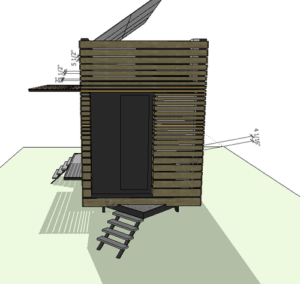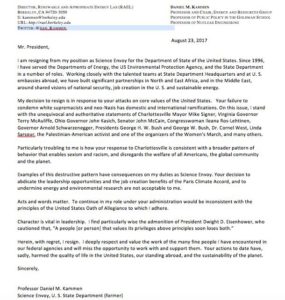

That is Sisyphus contributor Tom Webster (beard, far left) and his son Brett (second from right) and blog post author Laney Siegner (far right) at the Sacramento Municipal Utility District’s (SMUD) Tiny Home Competition, with some of UC Berkeley’s team. UC Berkeley came in second place overall in the 2016 competition, but also took home the awards for home life, water conservation, sustainability, and craftsmanship. Colleges from around the country and the world participate in these environmental learning experiments that have the potential for innovation and widespread sustainability, reducing the carbon footprint. Brett became the first resident in the THIMBY house which temporarily found a home in Richmond, CA.
The following is Laney’s blog entry from February 10, 2017:

“A few weeks ago, THIMBY realized her second crucial stage of development: actually serving as a tiny home. One of THIMBY’s team members, Brett Webster, moved into THIMBY at the end of January, after weeks of hard work transitioning THIMBY from a demonstration home to a functioning structure capable of safely and comfortably storing a graduate student plus pared-down belongings. Well, really after a year of planning, designing, engineering, and building the tiny house from a trailer bed to a 210 sq. ft., off-grid tiny house with solar panels, a Tesla battery, and a home greywater filtration system.
Over the past two months, the 24/7 frenzy of work parties, all-nighters, and super-human efforts needed to get the house ready for the SMUD competition has been replaced by steady progress towards getting the house ready for a resident. Meaning, coats of shellac for waterproofing the windows, waterproofing the bathroom plywood, insulating the toilet box and building the sealed lid, building extra shelving units, and integrating the carbon filter into the planter box filtration loop. THIMBY no longer exists as a competition stunt, but is now a true “living lab” for testing out residential water and energy technologies with an actual resident.
The challenges and joys of tiny living have already presented themselves in obvious ways early into the living experiment. What could be better than biking home from campus, along the Bay Trail, to your own self-built tiny home, cooking dinner on an induction stovetop with lights and radiant floor heating all powered by solar panels and a super-efficient heat pump? And then… it rains for two weeks straight so the battery dies and the house needs to be plugged into the grid to come back on, and you need 240V power, and you can’t shower with hot water because the energy control system fell off the shelf when you moved the ladder to get up to the loft…
Speaking of showers, because the greywater filtration system is currently plumbed so that greywater is filtered through a layered planter box, activated carbon filter, and UV light before re-collecting in a filtered tank, which is the cold-water supply to the shower, you have to be really careful what you put down the sink or shower drains. Raw meat? Questionable. Blood? Probably ok, but worrisome at first. We’re testing out greywater filtration removal rates — for turbidity, BOD, COD, E. Coli, nitrates, etc. — in a Berkeley water quality lab, and will continue to gather data this spring on water quality and energy balance.
The first few weeks in THIMBY have proved how collaborative and flexible you have to be to pioneer the off-grid variant of tiny living. Calling up team members and friends to help with critical repairs, and settling in slowly by unpacking some things and moving anything non-essential to storage, are necessary and unavoidable parts of the experience. But, in the midst of thinking critically about sustainable living, it’s nice to realize you can still have 8 people over — to discuss the next variant of water treatment systems, or just share beers and grill out on the porch with the sun setting over Richmond Bay.”



The THIMBY graduate students are learning valuable skills and the program is thriving. Other millennials are also concerned about the future, as demonstrated by the number of schools participating in these environmental competitions. After all, environmental concerns are paramount in these times of extreme weather events like hurricanes Irma, Maria, and Harvey; the terminally burning western states; and the global anomalies that are beginning to become commonplace and students recognize that this issue must be addressed. In Oregon, youth aged 10-21 filed a constitutional climate lawsuit against the United States government for violating the youngest generation’s constitutional rights to life, liberty, and property, as well as failing to protect essential public trust resources. “Exercising my ‘reasoned judgment,’ I have no doubt that the right to a climate system capable of sustaining human life is fundamental to a free and ordered society,” says U.S. District Judge Ann Aiken.
It is certainly not the time to have withdrawn from the Paris Climate Summit Accords. Our elected representatives have the responsibility not to make such short-sighted decisions. The director of the THIMBY project, Daniel M. Kamman, is the Professor of Energy at UC Berkeley and Director of the Renewable and Appropriate Energy Lab (RAEL) and chair of Energy and Resources Group. He is a widely known and respected expert on climate change. Until April, he was also the Science Envoy to the State Department of the United States. Professor Kamman continues, as we all should, to be engaged in climate science. But below is his resignation letter from the U.S. State Department because of to the United States’ withdrawal from the Paris Accords and the President’s response to the Charlottesville riots (see “What is Sustainable, What Is Not, and What About Those Monuments?” in this issue). The first letter of each paragraph of his resignation letter spells out the word “IMPEACH.”

Sure would love to come over for SOLAR tea at THIMBY!